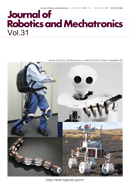Volume 31, Issue 3
Displaying 1-16 of 16 articles from this issue
- |<
- <
- 1
- >
- >|
Review on Introduction to Simultaneous Localization and Mapping
-
Article type: Review
2019 Volume 31 Issue 3 Pages 367-374
Published: June 20, 2019
Released on J-STAGE: June 20, 2019
Download PDF (3352K)
Special Issue on Education Based on Practical Exercise on Sensing and Control
-
Article type: Editorial
2019 Volume 31 Issue 3 Pages 375
Published: June 20, 2019
Released on J-STAGE: June 20, 2019
Download PDF (1557K) -
Article type: Paper
2019 Volume 31 Issue 3 Pages 376-382
Published: June 20, 2019
Released on J-STAGE: June 20, 2019
Download PDF (1317K) -
Article type: Paper
2019 Volume 31 Issue 3 Pages 383-390
Published: June 20, 2019
Released on J-STAGE: June 20, 2019
Download PDF (2488K) -
Article type: Paper
2019 Volume 31 Issue 3 Pages 391-404
Published: June 20, 2019
Released on J-STAGE: June 20, 2019
Download PDF (2197K) -
Article type: Paper
2019 Volume 31 Issue 3 Pages 405-411
Published: June 20, 2019
Released on J-STAGE: June 20, 2019
Download PDF (824K) -
Article type: Paper
2019 Volume 31 Issue 3 Pages 412-418
Published: June 20, 2019
Released on J-STAGE: June 20, 2019
Download PDF (603K) -
Article type: Paper
2019 Volume 31 Issue 3 Pages 419-426
Published: June 20, 2019
Released on J-STAGE: June 20, 2019
Download PDF (1748K) -
Article type: Paper
2019 Volume 31 Issue 3 Pages 427-433
Published: June 20, 2019
Released on J-STAGE: June 20, 2019
Download PDF (1394K) -
Article type: Paper
2019 Volume 31 Issue 3 Pages 434-440
Published: June 20, 2019
Released on J-STAGE: June 20, 2019
Download PDF (1206K) -
Article type: Paper
2019 Volume 31 Issue 3 Pages 441-451
Published: June 20, 2019
Released on J-STAGE: June 20, 2019
Download PDF (1643K)
Regular Papers
-
Article type: Paper
2019 Volume 31 Issue 3 Pages 453-463
Published: June 20, 2019
Released on J-STAGE: June 20, 2019
Download PDF (3015K) -
Article type: Paper
2019 Volume 31 Issue 3 Pages 464-473
Published: June 20, 2019
Released on J-STAGE: June 20, 2019
Download PDF (6989K) -
Article type: Paper
2019 Volume 31 Issue 3 Pages 474-492
Published: June 20, 2019
Released on J-STAGE: June 20, 2019
Download PDF (9724K) -
Article type: Paper
2019 Volume 31 Issue 3 Pages 493-499
Published: June 20, 2019
Released on J-STAGE: June 20, 2019
Download PDF (530K) -
Article type: Development Report
2019 Volume 31 Issue 3 Pages 500-506
Published: June 20, 2019
Released on J-STAGE: June 20, 2019
Download PDF (1595K)
- |<
- <
- 1
- >
- >|
